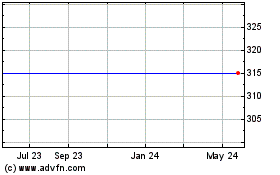By Julie Jargon
Restaurants are no longer treating lunchtime delivery as an
afterthought.
With online-ordering apps proliferating and many customers
cutting down on eating out for lunch, the industry -- from
fast-food chains to upscale restaurateurs -- is looking for ways to
bring food to patrons without compromising their eating
experience.
Wendy's Co. recently signed up with delivery service DoorDash
Inc. to offer delivery in parts of Ohio and Texas, with plans to
expand nationally within the year. "We fundamentally believe food
at home is our number one competitor," Wendy's Chief Concept and
Marketing Officer Kurt Kane said in a recent interview.
Rival McDonald's Corp. is now offering delivery in more than
2,000 U.S. restaurants using Uber Technologies Inc. "Restaurant
delivery is a $100 billion dollar market, and it's exploding," Lucy
Brady, McDonald's senior vice president of corporate strategy and
business development, told investors in March.
But enticing customers to order in at lunch, which has been a
tough spot for burger chains in particular, remains difficult.
McDonald's Chief Executive Steve Easterbrook told investors on
Wednesday that 60% of the chain's delivery orders come in the
evening and late at night.
Getting burger delivery right -- keeping the patty warm and
juicy, while preventing toppings from getting the bun soggy -- is
notoriously tricky.
DoorDash said its drivers keep packaged food warm by wrapping it
in "space blankets" -- thin plastic metallic sheets originally
developed by NASA to provide thermal control for spacecraft --
before placing them in insulated bags to ensure it arrives hot.
To keep McDonald's food as fresh as possible, Uber waits to
notify the local restaurant of the order it receives on its
UberEats app until the driver is three minutes away, an Uber
spokeswoman said. Because french fries don't stay hot and fresh for
long, they are the last item the restaurant makes and places in the
bag for delivery orders. Since McDonald's is so ubiquitous -- 75%
of the U.S. population lives within 3 miles of a McDonald's -- Uber
drivers don't have to place the food in any special containers.
Even upscale restaurants are joining the delivery bandwagon.
Some are so confident they are even eschewing tables and
chairs.
Oyster Bah in Chicago recently opened Seaside's, a delivery and
carry-out-only restaurant that operates out of Oyster Bah's kitchen
so that it can expand sales without any additional rental cost. It
only serves food that is designed to travel well, such as fried
chicken, ribs and grilled lobster, as opposed to Oyster Bah's
chilled fish and shrimp and raw oysters.
In New York, Ando, from Momofuku founder David Chang, was
created to be a delivery-only restaurant.
Delivery only accounts for 3% of restaurant purchases
nationwide, but it is growing fast. Non-pizza delivery purchases
have risen by 30% in the past four years, according to
market-research firm NPD Group Inc.
GrubHub Inc., one of many apps that have helped improve the
online-ordering and payment process, said it has more than 10,000
delivery drivers, from just a few hundred less than two years ago.
Its number of active diners, which it defines as those who have
placed at least one order in the past 12 months, grew 26% to 8.75
million in the first quarter from a year earlier.
The exponential growth of delivery comes with a new set of
challenges. Some restaurants are struggling to figure out how to
properly staff their kitchens to handle both in-store demand and
delivery orders.
Chipotle Mexican Grill Inc. has added a second food-assembly
line to nearly all its locations just to handle "off premise"
orders.
Working with third-party delivery services is an expensive
proposition, because many of them charge restaurants a hefty fee --
usually a share of order sales ranging from 17% to 30% -- to
participate and the restaurants lose out on high-margin sales like
alcohol and soft drinks that people tend to order when they are
eating on the premises.
It is also expensive for customers, who are already curtailing
restaurant visits, especially during lunch, as labor costs have
resulted in higher tabs. The fee that delivery services charge
customers often exceeds the cost of the meal at fast-food
restaurants. "We still haven't figured out how to get people
delivery in an affordable, fast fashion," Taco Bell Corp. Chief
Executive Brian Niccol told investors last week.
For example, a beef taco, burrito supreme and large fountain
drink at a Taco Bell in the Los Angeles area costs $6.39, but with
delivery and service fees added on, as well as a 10% tip for the
driver, the order totals $15.18, with an estimated delivery time of
33 to 43 minutes.
Some, like Panera Bread Co., are running their own delivery
operation. The fast-casual chain employs its own drivers and
recently announced plans to add 10,000 more this year, on top of
the roughly 4,000 it has now. Panera is rolling out a feature on
its own app that will allow customers to track the location of
their delivery driver, learn the expected arrival time and see a
photo of the driver, much like the app for ride-share services like
Uber.
Some restaurant executives say delivery goes against the very
purpose of operating a restaurant. "We are selling hospitality as
much as food," said Texas Roadhouse Inc. President Scott Colosi.
"We are not in the delivery game."
Yet he concedes that delivery is the future: "As driverless cars
and drones become the norm I think we'll all be emailing Amazon and
getting a drone delivering a sandwich."
Write to Julie Jargon at julie.jargon@wsj.com
(END) Dow Jones Newswires
June 01, 2017 11:15 ET (15:15 GMT)
Copyright (c) 2017 Dow Jones & Company, Inc.
Panera Bread Company (NASDAQ:PNRA)
Historical Stock Chart
From Nov 2024 to Dec 2024

Panera Bread Company (NASDAQ:PNRA)
Historical Stock Chart
From Dec 2023 to Dec 2024
